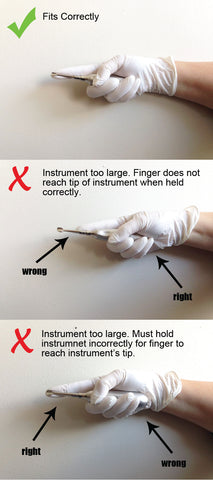- Receive an email notification when a new blog is released!
The most common questions we get from customers about elevators and luxating type elevators are how the instruments should fit in their hand, and what handle and shank size they need. Because the size of the instrument makes a big difference to ergonomics, comfort, technique, and the safety of the patient, it is important to know what handle and shank size fit you best.
How should dental elevators and luxating elevators fit?

With the end of the instrument’s handle resting in the center of your palm, your index finger should be able to comfortably reach the end of the tip (as shown in the picture to the left). Being able to keep your index fingertip at the end of the instrument gives you more control, and results in less chance of damaging the patient in case of slippage. Because your palm and the base of your thumb keep the instrument from slipping towards your wrist, you avoid the need for an extremely tight grip on the instrument, thereby promoting proper use and eliminating hand strain or fatigue. When using the instrument properly, your hand should be relaxed, allowing all the power to come from your shoulder.
When practices have multiple people sharing elevators and luxating elevators, it is best to fit the instruments to the smallest hand. An instrument that is too small for you is much easier to control than one that is too large, because you can curl your index finger to meet the tip and still hold the instrument correctly. If you use an instrument that is too big, you are forced to choose between holding it correctly or having your finger reach the tip of the instrument to properly protect your patient. The only instance when this does not stand true is if there is a person with a 5.5 glove size and a person with a size 8 glove sharing the same instruments. In this scenario it is best for each individual to have their own instruments, as the size difference is just too great.
Glove Size vs. Handle and Shank Size
To help you determine what handle and shank size will best fit you based on your surgical glove size, we have created this handy chart below.
In some instances two people with the same glove size may fit an instrument differently because of the length of their fingers. This is why the above chart gives both XS and regular shank size as an option for the same glove size.
Winged Elevator vs. Non-Winged Elevator Shank Size
You will also notice in the Glove Size vs. Handle and Shank Size chart that the recommended shank size can differ depending on whether you are using winged or non-winged elevators. This is because the standard shank size of winged elevators are already shorter than non-winged elevators and luxating elevators. You can see this clearly demonstrated in the image below.
Comparing Handles
As you can see in the image below, the 501 handle is quite large, both in length and width. Those with a size of 8 glove or larger are typically the only people that properly fit this handle size. The 503 handle is compatible with those who have a glove size between 6 and 7.5, and the RTH3 handle for those with a size 5.5 or smaller.

We hope that you have found this information helpful. If you have any questions or concerns regarding handle or shank size or how an instrument should fit in your hand, please feel free to contact us for more information.
- Receive an email notification when a new blog is released!

